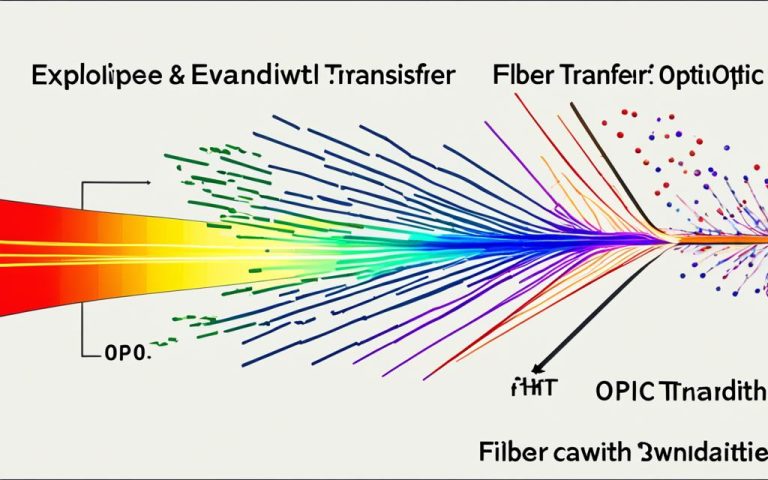In an era driven by seamless connectivity and lightning-fast data transfer, fiber optic networks play a pivotal role in providing high-speed, reliable communication infrastructure. Fiber optic technology has revolutionized telecommunications, offering unprecedented speed, reliability, and capacity. The global market for fiber optics is growing rapidly and is expected to reach $11.5 billion by 2030. To build robust fiber optic networks, operators need to follow key design principles and employ best practices.
Reliable communication infrastructure is essential for various industries, including telecommunications, healthcare, finance, and transportation. Fiber optic networks provide the ideal solution for these sectors due to their ability to support high-speed data transfer over long distances without signal degradation. This ensures uninterrupted communication, efficient data transmission, and optimal performance.
To achieve reliable communication infrastructure, fiber optic network design must consider factors such as network topology, cable routing, equipment selection, and capacity planning. By carefully designing and implementing fiber optic networks, operators can create a robust infrastructure that meets the increasing demands of digital connectivity.
In the following sections, we will explore the key principles and best practices for designing fiber optic networks. We will discuss the planning and design process, the global market for fiber optics, essential steps in design and implementation, component selection, considerations for low latency, and the importance of adhering to best practices. By following these guidelines, operators can ensure reliable connectivity and high-performance communication infrastructure.
Understanding Fiber Optic Network Design and Planning
Fiber optic network design and planning involve various steps and considerations. To build a successful fiber network, operators must follow a structured approach that encompasses technical and business aspects.
Planning Phase
In the initial planning phase, operators set the foundation for a well-designed fiber network. This involves defining communication protocols, selecting transmission equipment, and establishing network topology. By carefully considering these factors, operators can ensure optimal performance and efficient data transfer.
During the planning process, operators must also address technical and business considerations. Technical considerations include evaluating current and future bandwidth requirements, assessing the availability of technical resources, and identifying potential bottlenecks that may impact network performance. Business considerations involve evaluating the return on investment, estimating project costs, and developing a robust business model.
Additionally, operators must navigate the regulatory landscape, ensuring compliance with permits and inspections. This involves obtaining necessary approvals for right-of-way access and adhering to local regulations and ordinances.
Collaborative digital platforms play a crucial role in streamlining the design and planning process. These platforms facilitate information sharing, real-time communication, and collaboration among different stakeholders, ultimately enhancing efficiency and reducing project timelines.
| Technical Considerations | Business Considerations |
|---|---|
| Bandwidth requirements | Return on investment |
| Technical resources availability | Project costs estimation |
| Potential bottlenecks | Development of a robust business model |
Table: Considerations in Fiber Network Design
By considering both technical and business aspects, operators can design a fiber network that not only meets current demands but is also scalable for future growth. This comprehensive approach ensures a well-rounded and successful fiber optic network design and planning process.
Exploring the Global Market for Fiber Optic Networks
The global market for fiber optic networks is witnessing rapid expansion, driven by the increasing demand for high-speed broadband services. With its enhanced capabilities compared to copper cables, fiber optic technology has become the dominant choice for broadband access in many countries. As a result, customers are increasingly favoring fiber platforms to achieve faster and more reliable broadband services.
Fueled by growing demand, the global fiber optic market is projected to reach $11.5 billion by 2030, highlighting the significant growth potential in the industry. This surge is primarily attributed to the continuous advancements in fiber optics, enabling efficient data transmission and meeting the escalating needs for high-speed connectivity.

Key Factors Driving the Global Fiber Optic Market
- Increased Bandwidth Demand: The exponential rise in data consumption, driven by digitalization and the proliferation of connected devices, is fueling the need for fiber optic networks to cater to the growing bandwidth requirements.
- Reliable and Efficient Connectivity: Fiber optics offer higher reliability and data transfer rates, allowing businesses and consumers to enjoy seamless connectivity even during peak usage periods. This reliability is essential for applications such as video streaming, online gaming, cloud services, and IoT devices.
- Future-Proof Infrastructure: Fiber optic networks provide a future-proof infrastructure that can easily accommodate technological advancements and emerging trends, making them an attractive option for long-term investments.
Regional Market Outlook
The global market for fiber optic networks is witnessing substantial growth across various regions. Here are the key highlights:
| Region | Key Growth Drivers |
|---|---|
| North America | Increasing demand for high-speed internet and adoption of fiber-to-the-home (FTTH) technology |
| Europe | Government initiatives for fiber optic network expansion and rising investments in 5G infrastructure |
| Asia Pacific | Rapid urbanization, increasing internet penetration, and rising demand for high-definition video streaming |
| Middle East & Africa | Investments in digital transformation initiatives and expanding telecommunication networks |
| Latin America | Growing need for high-speed connectivity in urban areas and rising internet adoption |
10 Steps in Fiber Network Design and Implementation
Designing and implementing a fiber optic network involves a series of essential steps to ensure efficient and reliable connectivity. By following these steps, operators can create a robust network that meets the specific requirements of their organization or project.
- Step 1: Planning and Requirements Gathering
Start the design process by carefully assessing the coverage area, bandwidth demand, and the specific services that the network needs to support. This step involves gathering key information and understanding the specific needs of the network.
- Step 2: Site Surveys and Feasibility Studies
Conduct thorough site surveys to assess the physical infrastructure and identify potential obstacles that may impact network deployment. Feasibility studies evaluate the economic viability of the project and identify any potential challenges or limitations.
- Step 3: Network Topology Design
Design the network topology, considering factors such as scalability, redundancy, and ease of maintenance. Choose the appropriate architecture that aligns with the network requirements and goals.
- Step 4: Fiber Optic Cable Routing
Determine the optimal routes for fiber optic cable installation, taking into account factors like distance, terrain, existing infrastructure, and potential environmental hazards.
- Step 5: Equipment Selection
Choose the appropriate equipment, including fiber optic cables, connectors, switches, routers, and other devices. Consider factors such as capacity, reliability, compatibility, and scalability.
- Step 6: Capacity and Bandwidth Planning
Estimate the network’s capacity and bandwidth requirements to ensure optimal performance and accommodate future growth. Proper capacity planning helps avoid congestion and bottlenecks.
- Step 7: Power and Infrastructure Planning
Consider power requirements for the network components and plan for infrastructure needs such as power distribution, cooling, and physical security.
- Step 8: Network Documentation
Create comprehensive documentation that includes network configurations, diagrams, and any specific guidelines for network management. Proper documentation ensures ease of maintenance and troubleshooting.
- Step 9: Implementation Testing
Thoroughly test the implemented network to verify its performance, identify any issues or bottlenecks, and optimize the network settings for maximum efficiency.
- Step 10: Network Monitoring and Maintenance
Set up a monitoring system to proactively detect any anomalies or performance issues in the network. Establish a regular maintenance schedule to ensure the network remains reliable and performs optimally over time.
Example of a Fiber Optic Network Design Plan:
Here’s an example of a well-structured fiber optic network design plan:
| Step | Description |
|---|---|
| Step 1 | Gather requirements and understand project scope. |
| Step 2 | Conduct site surveys and feasibility studies. |
| Step 3 | Design network topology and determine equipment needs. |
| Step 4 | Plan fiber optic cable routing. |
| Step 5 | Select appropriate fiber optic cables, connectors, switches, and routers. |
| Step 6 | Estimate network capacity and bandwidth requirements. |
| Step 7 | Plan for power and infrastructure needs. |
| Step 8 | Create detailed network documentation. |
| Step 9 | Perform implementation testing and optimization. |
| Step 10 | Establish network monitoring and maintenance procedures. |
Following these steps ensures that the fiber optic network is designed and implemented properly, resulting in efficient and reliable connectivity.
Choosing Components for Fiber Optic Network Design
When it comes to designing a reliable and high-performing fiber optic network, selecting the right components is crucial. From fiber optic cables to switches and routers, each component plays a vital role in ensuring efficient data transmission and network performance. In this section, we will explore the key considerations for equipment selection and how capacity and bandwidth planning are essential for optimizing network performance.
Selecting Fiber Optic Components
Operators need to carefully evaluate their requirements and specifications when choosing fiber optic components. Here are some key factors to consider:
- Capacity: Ensure that the selected components can handle the required capacity of the network.
- Reliability: Opt for components from reputable manufacturers known for their reliable performance.
- Scalability: Choose components that can easily accommodate future expansions and upgrades.
- Compatibility: Ensure that the selected components are compatible with the existing infrastructure.
By considering these factors, operators can design a fiber optic network that meets their specific needs and provides a solid foundation for future growth.
Capacity and Bandwidth Planning
Capacity and bandwidth planning are crucial aspects of fiber optic network design. By estimating resource requirements and optimizing network performance, operators can ensure smooth operations and reliable connectivity. Planning should encompass:
- Assessing demand: Understand the bandwidth needs and traffic patterns to determine the required capacity.
- Estimating growth: Anticipate future growth and scalability requirements to avoid capacity limitations.
- Utilizing redundancy: Implement redundant components to minimize downtime and ensure continuous service availability.
- Monitoring and optimization: Regularly monitor network performance and optimize capacity allocation to maintain efficiency.
By effectively planning and allocating capacity and bandwidth, operators can optimize network performance, minimize bottlenecks, and provide a seamless and reliable user experience.
Now that we have explored the vital role of component selection and capacity planning, let’s dive deeper into the design considerations for minimizing latency in fiber optic networks.

Designing for Low Latency in Fiber Optic Networks
When it comes to fiber optic networks, designing for low latency is essential, especially for applications that require real-time communication. Low latency ensures that data can be transmitted quickly and without significant delays, enabling smooth and efficient operations.
To achieve low latency in fiber optic networks, operators must carefully assess their needs and goals. Factors such as bandwidth, distance, reliability, and security requirements should be taken into consideration during the design process.
Minimizing losses and errors is another crucial aspect of low latency design. By using proper installation techniques, conducting thorough testing, and implementing effective maintenance practices, operators can reduce signal losses and errors that can lead to latency issues.
Optimizing routing and switching is also key to achieving low latency in fiber optic networks. By employing efficient algorithms, protocols, and load balancing techniques, operators can improve data transmission speed and reduce delays and congestion.
Here are some strategies for designing fiber optic networks with low latency:
- Use high-quality fiber optic cables and connectors to minimize signal losses.
- Implement effective error detection and correction mechanisms to reduce transmission errors.
- Design network topologies that optimize routing and minimize data travel distance.
- Employ advanced switching technologies, such as cut-through or store-and-forward, to minimize processing delays.
- Leverage intelligent traffic management techniques, such as Quality of Service (QoS) policies and traffic shaping, to prioritize critical data and reduce congestion.
- Regularly monitor and troubleshoot the network to identify and resolve latency issues promptly.
By following these strategies, operators can design fiber optic networks with low latency, ensuring smooth and seamless communication for latency-sensitive applications.
“Low latency design is crucial for industries such as finance, gaming, and real-time monitoring, where even a small delay can have significant consequences. By minimizing latency, organizations can enhance user experiences, improve operational efficiency, and gain a competitive edge.”
Next, we will explore the importance of component selection in fiber optic network design and how it impacts overall performance and reliability.
Conclusion
Designing robust fiber optic networks requires adherence to best practices and key principles. By following the steps in fiber network design and implementation and considering factors like capacity, equipment selection, and latency, operators can ensure reliable connectivity and high-performance communication infrastructure.
Fiber optic networks play a crucial role in meeting the growing demand for high-speed broadband services. With their unparalleled speed, reliability, and capacity, they are poised to play an even more significant role in the future. As the global market for fiber optics continues to expand, operators must stay updated with the latest technological advancements and industry trends to deliver optimal performance to their customers.
Integrating fiber optic components, such as cables, connectors, and transceivers, that match the requirements and specifications of a network ensures efficient data transmission and ease of maintenance. Capacity and bandwidth planning are also vital for estimating resource requirements and optimizing network performance. Additionally, designing for low latency by minimizing losses and errors and optimizing routing and switching further enhances the overall network experience.
In summary, effective fiber optic network design is essential for building reliable communication infrastructure. By incorporating best practices and paying attention to important factors, operators can create networks that deliver high-speed, efficient, and seamless connectivity, meeting both current and future demands.
FAQ
What are the key design principles for robust fiber optic networks?
The key design principles for robust fiber optic networks include proper planning and requirements gathering, efficient network topology design, careful selection of components, capacity and bandwidth planning, and low latency design considerations.
What is involved in fiber optic network design and planning?
Fiber optic network design and planning involves several steps, including defining communication protocols, selecting transmission equipment, setting network topology, considering technical and business aspects, obtaining permits and inspections, and utilizing collaborative digital platforms for streamlined communication and information sharing.
How is the global market for fiber optic networks expanding?
The global market for fiber optic networks is growing rapidly due to the increasing demand for high-speed broadband services. Fiber optic technology is preferred over copper cables for its superior capabilities in meeting connectivity needs, making it the dominant broadband access technology in many countries. The market is projected to reach .5 billion by 2030.
What are the steps in fiber network design and implementation?
The steps in fiber network design and implementation include planning and requirements gathering, conducting site surveys and feasibility studies, designing network topology and fiber optic cable routing, selecting appropriate equipment, planning for capacity and bandwidth, considering power and infrastructure requirements, documenting the network, and conducting implementation testing for configuration verification.
How do I choose components for fiber optic network design?
To choose components for fiber optic network design, operators need to consider their specific requirements and specifications. Factors such as capacity, reliability, scalability, and compatibility with existing infrastructure should be evaluated. Optimal component selection ensures efficient data transmission, network performance, and ease of maintenance.
How do I design for low latency in fiber optic networks?
Designing for low latency in fiber optic networks involves assessing bandwidth, distance, reliability, and security requirements. Minimizing losses and errors through proper installation techniques, testing, and maintenance practices is important. Optimizing routing and switching by using efficient algorithms, protocols, and load balancing techniques can also help reduce delays and congestion. Monitoring and troubleshooting are crucial for detecting and resolving latency issues.
What are the best practices for designing robust fiber optic networks?
The best practices for designing robust fiber optic networks include following the steps in fiber network design and implementation, considering factors such as capacity, equipment selection, and latency, and adhering to design principles. By doing so, operators can ensure reliable connectivity and high-performance communication infrastructure to meet the growing demand for high-speed broadband services.



















